Ethical Analysis of Nike: Business and Stakeholder Impact Report
VerifiedAdded on 2020/10/05
|11
|3204
|405
Report
AI Summary
This report provides a comprehensive analysis of Nike's business ethics, focusing on a case study involving a marketing campaign for the NikeLab NRG Beryllium Balaclava x MMW. The report identifies ethical issues related to the promotional material, particularly the use of a young black model, and its potential impact on social values. It delves into stakeholder perspectives, including customers, government, and investors, and examines the influence of ethical choices on these groups. Furthermore, the report explores two ethical theories, Teleological (Utilitarian) and Deontological, and their applicability to Nike's decision-making processes. The analysis extends to the qualities of ethical leadership and the creation of an ethical organization within the context of the Nike brand. The report concludes by emphasizing the importance of ethical considerations in business practices and their effects on stakeholders. The document is contributed by a student to be published on the website Desklib.

Business Ethics and
Responsible Management
Responsible Management
Paraphrase This Document
Need a fresh take? Get an instant paraphrase of this document with our AI Paraphraser
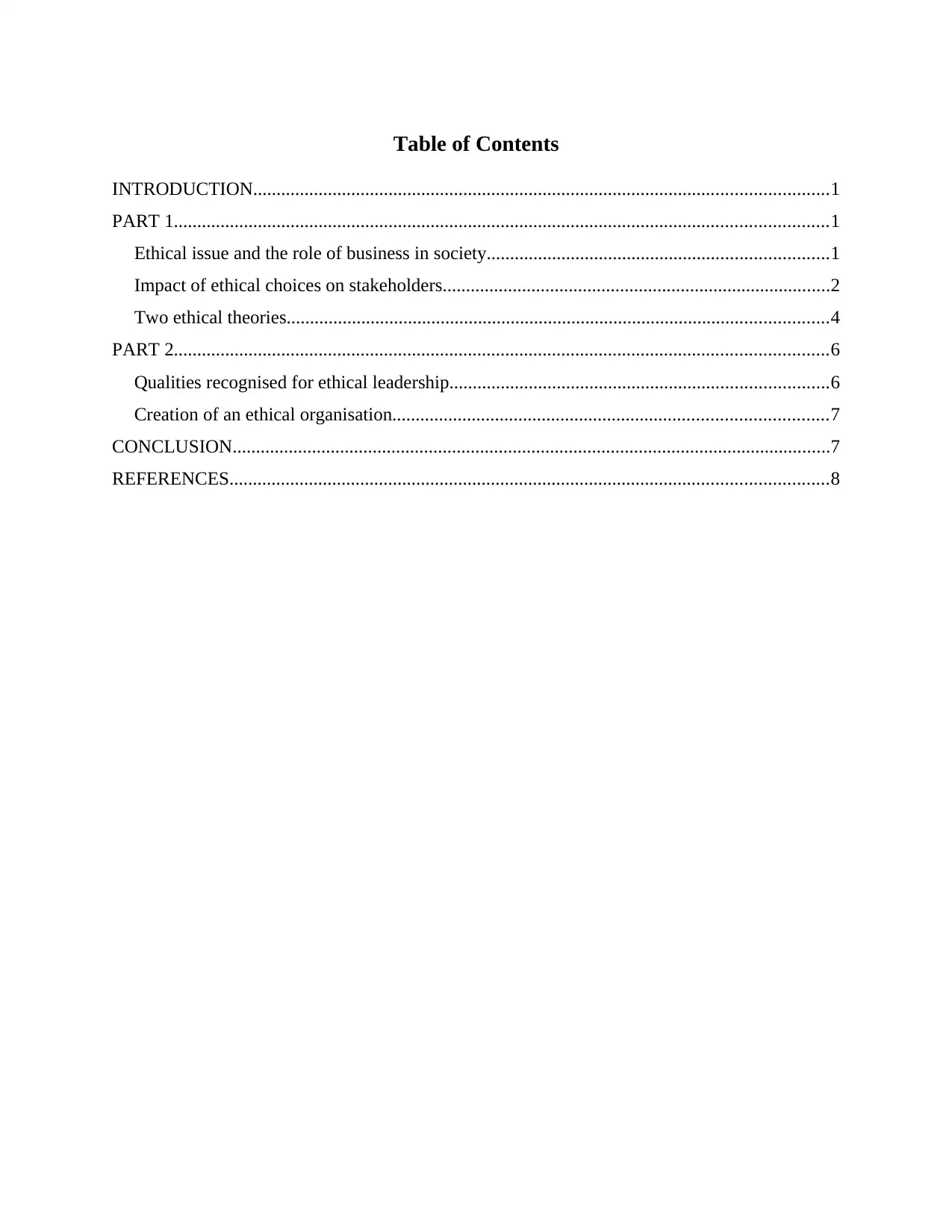
Table of Contents
INTRODUCTION...........................................................................................................................1
PART 1............................................................................................................................................1
Ethical issue and the role of business in society.........................................................................1
Impact of ethical choices on stakeholders...................................................................................2
Two ethical theories....................................................................................................................4
PART 2............................................................................................................................................6
Qualities recognised for ethical leadership.................................................................................6
Creation of an ethical organisation.............................................................................................7
CONCLUSION................................................................................................................................7
REFERENCES................................................................................................................................8
INTRODUCTION...........................................................................................................................1
PART 1............................................................................................................................................1
Ethical issue and the role of business in society.........................................................................1
Impact of ethical choices on stakeholders...................................................................................2
Two ethical theories....................................................................................................................4
PART 2............................................................................................................................................6
Qualities recognised for ethical leadership.................................................................................6
Creation of an ethical organisation.............................................................................................7
CONCLUSION................................................................................................................................7
REFERENCES................................................................................................................................8

⊘ This is a preview!⊘
Do you want full access?
Subscribe today to unlock all pages.

Trusted by 1+ million students worldwide
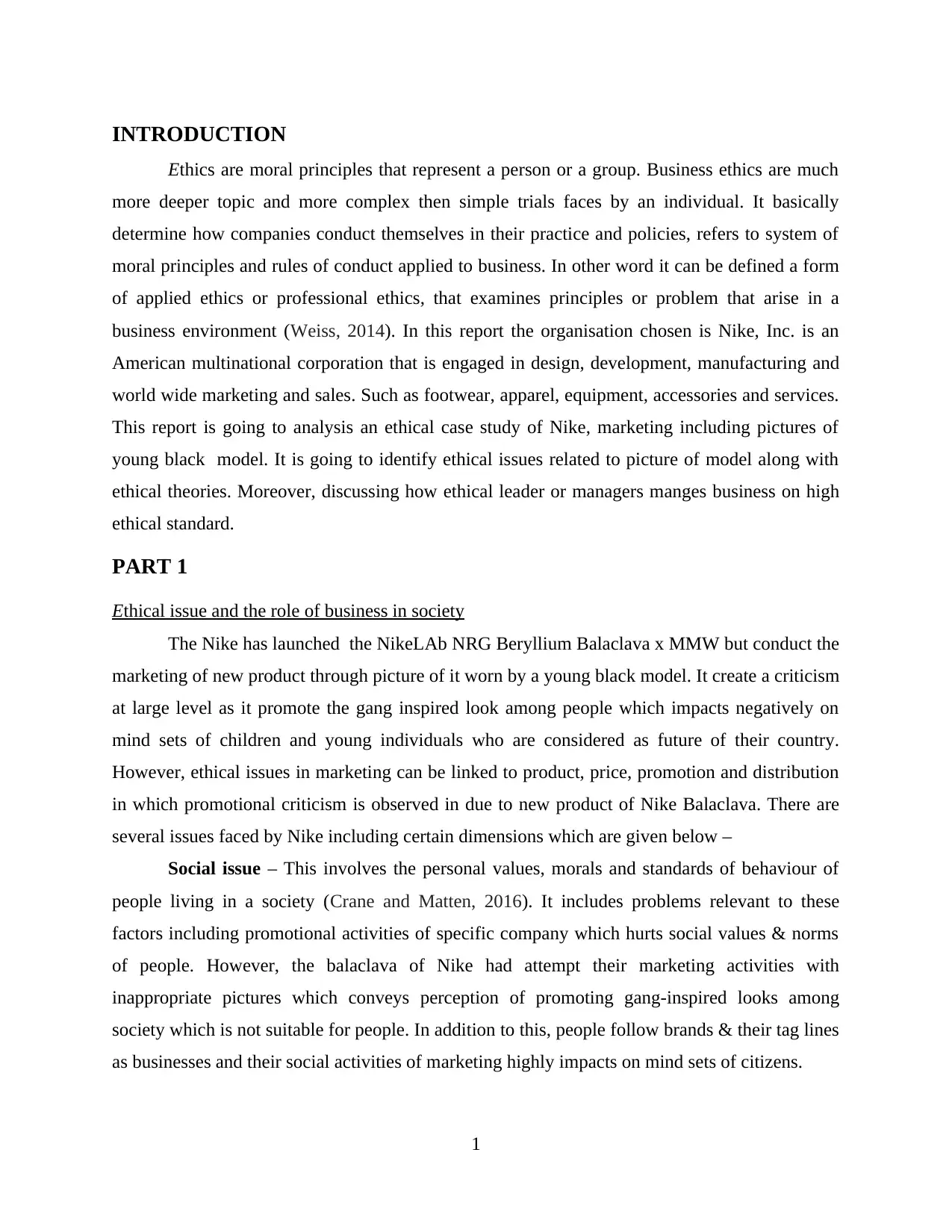
INTRODUCTION
Ethics are moral principles that represent a person or a group. Business ethics are much
more deeper topic and more complex then simple trials faces by an individual. It basically
determine how companies conduct themselves in their practice and policies, refers to system of
moral principles and rules of conduct applied to business. In other word it can be defined a form
of applied ethics or professional ethics, that examines principles or problem that arise in a
business environment (Weiss, 2014). In this report the organisation chosen is Nike, Inc. is an
American multinational corporation that is engaged in design, development, manufacturing and
world wide marketing and sales. Such as footwear, apparel, equipment, accessories and services.
This report is going to analysis an ethical case study of Nike, marketing including pictures of
young black model. It is going to identify ethical issues related to picture of model along with
ethical theories. Moreover, discussing how ethical leader or managers manges business on high
ethical standard.
PART 1
Ethical issue and the role of business in society
The Nike has launched the NikeLAb NRG Beryllium Balaclava x MMW but conduct the
marketing of new product through picture of it worn by a young black model. It create a criticism
at large level as it promote the gang inspired look among people which impacts negatively on
mind sets of children and young individuals who are considered as future of their country.
However, ethical issues in marketing can be linked to product, price, promotion and distribution
in which promotional criticism is observed in due to new product of Nike Balaclava. There are
several issues faced by Nike including certain dimensions which are given below –
Social issue – This involves the personal values, morals and standards of behaviour of
people living in a society (Crane and Matten, 2016). It includes problems relevant to these
factors including promotional activities of specific company which hurts social values & norms
of people. However, the balaclava of Nike had attempt their marketing activities with
inappropriate pictures which conveys perception of promoting gang-inspired looks among
society which is not suitable for people. In addition to this, people follow brands & their tag lines
as businesses and their social activities of marketing highly impacts on mind sets of citizens.
1
Ethics are moral principles that represent a person or a group. Business ethics are much
more deeper topic and more complex then simple trials faces by an individual. It basically
determine how companies conduct themselves in their practice and policies, refers to system of
moral principles and rules of conduct applied to business. In other word it can be defined a form
of applied ethics or professional ethics, that examines principles or problem that arise in a
business environment (Weiss, 2014). In this report the organisation chosen is Nike, Inc. is an
American multinational corporation that is engaged in design, development, manufacturing and
world wide marketing and sales. Such as footwear, apparel, equipment, accessories and services.
This report is going to analysis an ethical case study of Nike, marketing including pictures of
young black model. It is going to identify ethical issues related to picture of model along with
ethical theories. Moreover, discussing how ethical leader or managers manges business on high
ethical standard.
PART 1
Ethical issue and the role of business in society
The Nike has launched the NikeLAb NRG Beryllium Balaclava x MMW but conduct the
marketing of new product through picture of it worn by a young black model. It create a criticism
at large level as it promote the gang inspired look among people which impacts negatively on
mind sets of children and young individuals who are considered as future of their country.
However, ethical issues in marketing can be linked to product, price, promotion and distribution
in which promotional criticism is observed in due to new product of Nike Balaclava. There are
several issues faced by Nike including certain dimensions which are given below –
Social issue – This involves the personal values, morals and standards of behaviour of
people living in a society (Crane and Matten, 2016). It includes problems relevant to these
factors including promotional activities of specific company which hurts social values & norms
of people. However, the balaclava of Nike had attempt their marketing activities with
inappropriate pictures which conveys perception of promoting gang-inspired looks among
society which is not suitable for people. In addition to this, people follow brands & their tag lines
as businesses and their social activities of marketing highly impacts on mind sets of citizens.
1
Paraphrase This Document
Need a fresh take? Get an instant paraphrase of this document with our AI Paraphraser
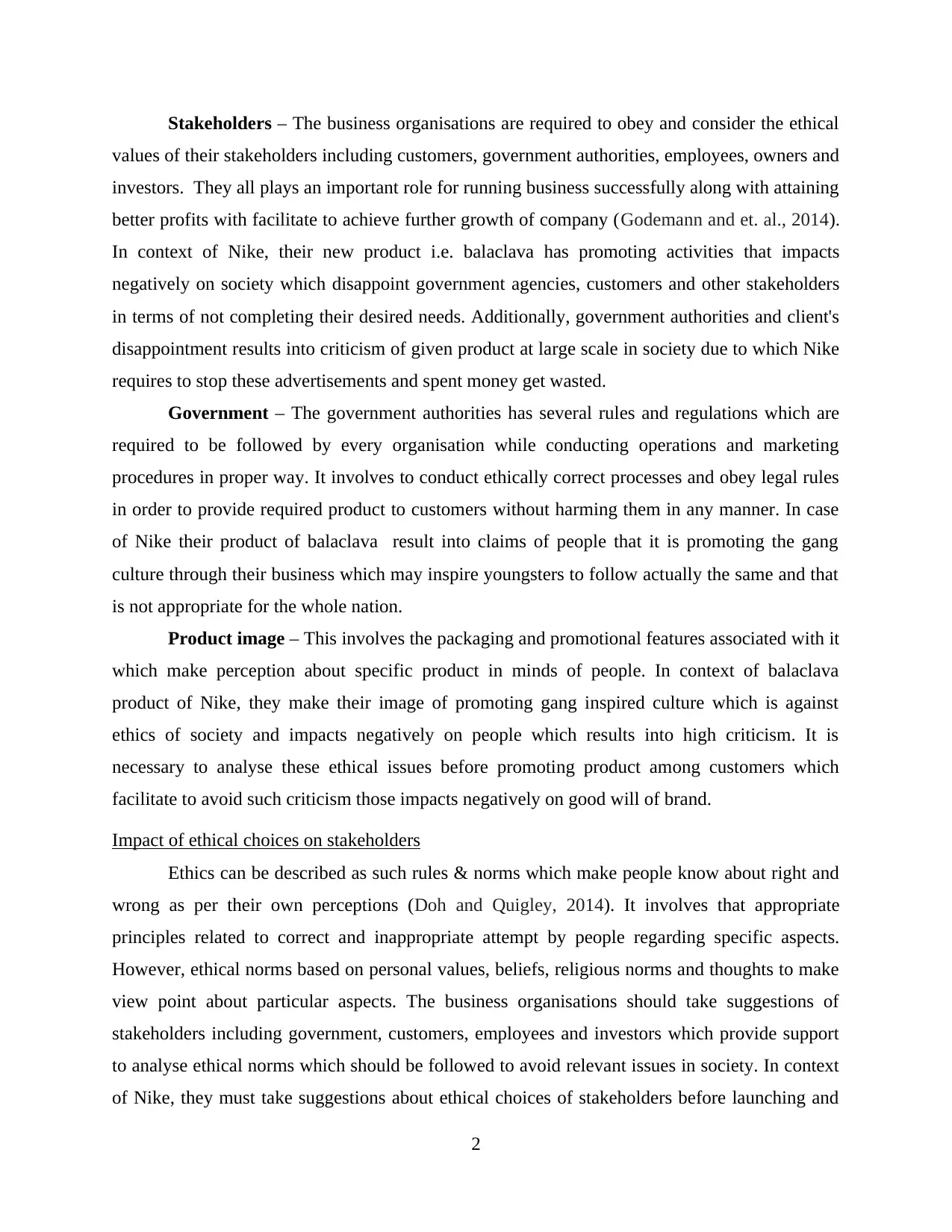
Stakeholders – The business organisations are required to obey and consider the ethical
values of their stakeholders including customers, government authorities, employees, owners and
investors. They all plays an important role for running business successfully along with attaining
better profits with facilitate to achieve further growth of company (Godemann and et. al., 2014).
In context of Nike, their new product i.e. balaclava has promoting activities that impacts
negatively on society which disappoint government agencies, customers and other stakeholders
in terms of not completing their desired needs. Additionally, government authorities and client's
disappointment results into criticism of given product at large scale in society due to which Nike
requires to stop these advertisements and spent money get wasted.
Government – The government authorities has several rules and regulations which are
required to be followed by every organisation while conducting operations and marketing
procedures in proper way. It involves to conduct ethically correct processes and obey legal rules
in order to provide required product to customers without harming them in any manner. In case
of Nike their product of balaclava result into claims of people that it is promoting the gang
culture through their business which may inspire youngsters to follow actually the same and that
is not appropriate for the whole nation.
Product image – This involves the packaging and promotional features associated with it
which make perception about specific product in minds of people. In context of balaclava
product of Nike, they make their image of promoting gang inspired culture which is against
ethics of society and impacts negatively on people which results into high criticism. It is
necessary to analyse these ethical issues before promoting product among customers which
facilitate to avoid such criticism those impacts negatively on good will of brand.
Impact of ethical choices on stakeholders
Ethics can be described as such rules & norms which make people know about right and
wrong as per their own perceptions (Doh and Quigley, 2014). It involves that appropriate
principles related to correct and inappropriate attempt by people regarding specific aspects.
However, ethical norms based on personal values, beliefs, religious norms and thoughts to make
view point about particular aspects. The business organisations should take suggestions of
stakeholders including government, customers, employees and investors which provide support
to analyse ethical norms which should be followed to avoid relevant issues in society. In context
of Nike, they must take suggestions about ethical choices of stakeholders before launching and
2
values of their stakeholders including customers, government authorities, employees, owners and
investors. They all plays an important role for running business successfully along with attaining
better profits with facilitate to achieve further growth of company (Godemann and et. al., 2014).
In context of Nike, their new product i.e. balaclava has promoting activities that impacts
negatively on society which disappoint government agencies, customers and other stakeholders
in terms of not completing their desired needs. Additionally, government authorities and client's
disappointment results into criticism of given product at large scale in society due to which Nike
requires to stop these advertisements and spent money get wasted.
Government – The government authorities has several rules and regulations which are
required to be followed by every organisation while conducting operations and marketing
procedures in proper way. It involves to conduct ethically correct processes and obey legal rules
in order to provide required product to customers without harming them in any manner. In case
of Nike their product of balaclava result into claims of people that it is promoting the gang
culture through their business which may inspire youngsters to follow actually the same and that
is not appropriate for the whole nation.
Product image – This involves the packaging and promotional features associated with it
which make perception about specific product in minds of people. In context of balaclava
product of Nike, they make their image of promoting gang inspired culture which is against
ethics of society and impacts negatively on people which results into high criticism. It is
necessary to analyse these ethical issues before promoting product among customers which
facilitate to avoid such criticism those impacts negatively on good will of brand.
Impact of ethical choices on stakeholders
Ethics can be described as such rules & norms which make people know about right and
wrong as per their own perceptions (Doh and Quigley, 2014). It involves that appropriate
principles related to correct and inappropriate attempt by people regarding specific aspects.
However, ethical norms based on personal values, beliefs, religious norms and thoughts to make
view point about particular aspects. The business organisations should take suggestions of
stakeholders including government, customers, employees and investors which provide support
to analyse ethical norms which should be followed to avoid relevant issues in society. In context
of Nike, they must take suggestions about ethical choices of stakeholders before launching and
2

promoting the product i.e. balaclava as it facilitate evaluate problem of gang-inspired culture and
solved immediately at organisational levels. Moreover, it will provide support to remove that
specific threat in order to gain positive response for customer. Meanwhile, impacts of ethical
choices on stakeholders –
Customers – The ethical rules and norms are responsible to provide correct path for
conducting various business procedures and activities to complete their goals of increasing
profits (Wood and et. al., 2015). It is helpful for an organisation to manufacture accurate
products as per actual desires of consumers to satisfy them and motivating them to convince for
purchasing through appropriate promotional activities. Moreover, it is essential to analyse actual
ethical values of target customers in order attain positive response of people along with avoiding
relevant problems. In context of Nike, they should considers ethical beliefs of clients and drop
idea of pictures for promotion and adopt some another concept favourable to society. The idea of
black model of given company impacts negatively on mind sets of youngsters and children as it
reflects about gang culture.
Staff members – The ethical norms should be followed by company because they
provide support to fulfil needs of people appropriately without creating any social issue. It is
helpful to boost up productivity as well as profitability of particular product which facilitate to
improve incentives of employees working in organisation. The Nike ignore ethics regarding the
balaclava product which results into criticism at large level which impacts negatively on image
of that product due to that it will not able to gain desired profit. The efforts of marketing
employees get wasted and incentives of them also get reduced.
Government authorities – This involves different legal rules & regulations which are
made by government authorities for protecting customers and ensure accuracy of services
(Ferrero and Sison, 2014). It helps customers to avoid frauds and wrong attempts by companies
with them and gain desired products to fulfil their actual neds and wants. In addition to this,
companies pay taxes to government from their achieved profits which increase annual income of
country which can be used in development of the nation. In case of Nike, they did not consider
ethical norm and create social issue by their black model which impacts negatively on
government by reducing their own profitability and increase expense of government agencies to
solve relevant criticism.
3
solved immediately at organisational levels. Moreover, it will provide support to remove that
specific threat in order to gain positive response for customer. Meanwhile, impacts of ethical
choices on stakeholders –
Customers – The ethical rules and norms are responsible to provide correct path for
conducting various business procedures and activities to complete their goals of increasing
profits (Wood and et. al., 2015). It is helpful for an organisation to manufacture accurate
products as per actual desires of consumers to satisfy them and motivating them to convince for
purchasing through appropriate promotional activities. Moreover, it is essential to analyse actual
ethical values of target customers in order attain positive response of people along with avoiding
relevant problems. In context of Nike, they should considers ethical beliefs of clients and drop
idea of pictures for promotion and adopt some another concept favourable to society. The idea of
black model of given company impacts negatively on mind sets of youngsters and children as it
reflects about gang culture.
Staff members – The ethical norms should be followed by company because they
provide support to fulfil needs of people appropriately without creating any social issue. It is
helpful to boost up productivity as well as profitability of particular product which facilitate to
improve incentives of employees working in organisation. The Nike ignore ethics regarding the
balaclava product which results into criticism at large level which impacts negatively on image
of that product due to that it will not able to gain desired profit. The efforts of marketing
employees get wasted and incentives of them also get reduced.
Government authorities – This involves different legal rules & regulations which are
made by government authorities for protecting customers and ensure accuracy of services
(Ferrero and Sison, 2014). It helps customers to avoid frauds and wrong attempts by companies
with them and gain desired products to fulfil their actual neds and wants. In addition to this,
companies pay taxes to government from their achieved profits which increase annual income of
country which can be used in development of the nation. In case of Nike, they did not consider
ethical norm and create social issue by their black model which impacts negatively on
government by reducing their own profitability and increase expense of government agencies to
solve relevant criticism.
3
⊘ This is a preview!⊘
Do you want full access?
Subscribe today to unlock all pages.

Trusted by 1+ million students worldwide

Investors – The investors are people who invest money to collect overall capital of
company which spent to conduct product and other related procedures to manufacture better
quality of products respectively. It is necessary for business concern to increase their profits on
which profit return of investors depends (Hoffman, Frederick and Schwartz, 2014). The criticism
of balaclava product of Nike will not provide any profit to their investors as product image get
affected by social issue of black model pictures which reflects about gang culture.
Two ethical theories
Ethical theories involves principles of morality and well defined standards of right and
wrong aspects, it will provide support to an individual to conduct in terms of obligations, rights,
rules, benefit for society, fairness and many more. However, the ethics encompasses human
rights and responsibilities in such a manner which leads to a better life, language of right or right
for citizens as well as society. Ethics can be classified into three categories including meta-
ethics, normative- ethics and applied- ethics. The different types of ethical norms relevant to
personal values, thoughts, religious beliefs and morals of people which make them capable to
evaluate right or wrong aspects to select correct things to attempt in daily life. Moreover, there
are several ethical theories such as Teleological or Utilitarian, Deontological, Virtue and System
development. Thus, two of them are explained further –
(Source: Deontology and Utilitarianism, 2018)
4
Illustration 1: Deontology and Utilitarianism
company which spent to conduct product and other related procedures to manufacture better
quality of products respectively. It is necessary for business concern to increase their profits on
which profit return of investors depends (Hoffman, Frederick and Schwartz, 2014). The criticism
of balaclava product of Nike will not provide any profit to their investors as product image get
affected by social issue of black model pictures which reflects about gang culture.
Two ethical theories
Ethical theories involves principles of morality and well defined standards of right and
wrong aspects, it will provide support to an individual to conduct in terms of obligations, rights,
rules, benefit for society, fairness and many more. However, the ethics encompasses human
rights and responsibilities in such a manner which leads to a better life, language of right or right
for citizens as well as society. Ethics can be classified into three categories including meta-
ethics, normative- ethics and applied- ethics. The different types of ethical norms relevant to
personal values, thoughts, religious beliefs and morals of people which make them capable to
evaluate right or wrong aspects to select correct things to attempt in daily life. Moreover, there
are several ethical theories such as Teleological or Utilitarian, Deontological, Virtue and System
development. Thus, two of them are explained further –
(Source: Deontology and Utilitarianism, 2018)
4
Illustration 1: Deontology and Utilitarianism
Paraphrase This Document
Need a fresh take? Get an instant paraphrase of this document with our AI Paraphraser
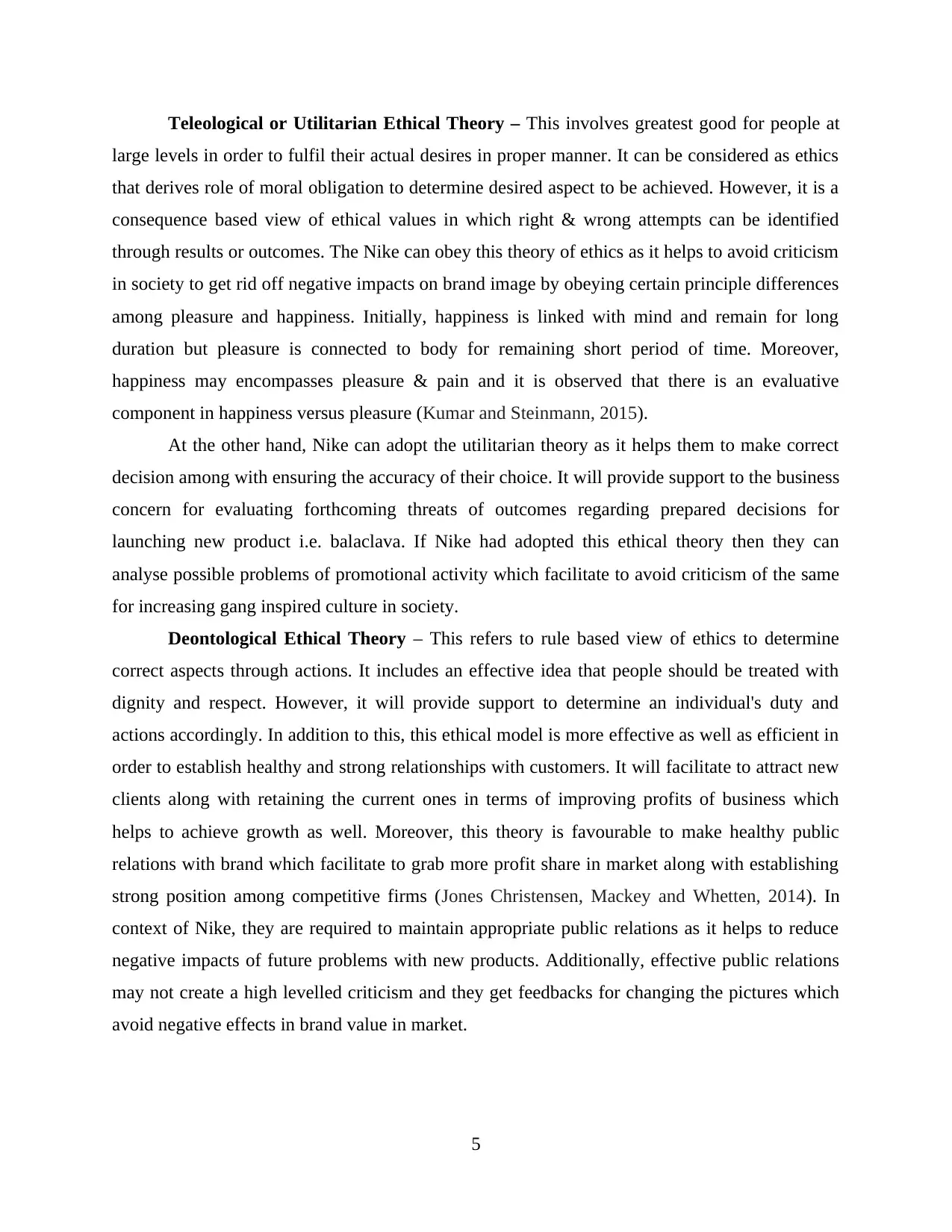
Teleological or Utilitarian Ethical Theory – This involves greatest good for people at
large levels in order to fulfil their actual desires in proper manner. It can be considered as ethics
that derives role of moral obligation to determine desired aspect to be achieved. However, it is a
consequence based view of ethical values in which right & wrong attempts can be identified
through results or outcomes. The Nike can obey this theory of ethics as it helps to avoid criticism
in society to get rid off negative impacts on brand image by obeying certain principle differences
among pleasure and happiness. Initially, happiness is linked with mind and remain for long
duration but pleasure is connected to body for remaining short period of time. Moreover,
happiness may encompasses pleasure & pain and it is observed that there is an evaluative
component in happiness versus pleasure (Kumar and Steinmann, 2015).
At the other hand, Nike can adopt the utilitarian theory as it helps them to make correct
decision among with ensuring the accuracy of their choice. It will provide support to the business
concern for evaluating forthcoming threats of outcomes regarding prepared decisions for
launching new product i.e. balaclava. If Nike had adopted this ethical theory then they can
analyse possible problems of promotional activity which facilitate to avoid criticism of the same
for increasing gang inspired culture in society.
Deontological Ethical Theory – This refers to rule based view of ethics to determine
correct aspects through actions. It includes an effective idea that people should be treated with
dignity and respect. However, it will provide support to determine an individual's duty and
actions accordingly. In addition to this, this ethical model is more effective as well as efficient in
order to establish healthy and strong relationships with customers. It will facilitate to attract new
clients along with retaining the current ones in terms of improving profits of business which
helps to achieve growth as well. Moreover, this theory is favourable to make healthy public
relations with brand which facilitate to grab more profit share in market along with establishing
strong position among competitive firms (Jones Christensen, Mackey and Whetten, 2014). In
context of Nike, they are required to maintain appropriate public relations as it helps to reduce
negative impacts of future problems with new products. Additionally, effective public relations
may not create a high levelled criticism and they get feedbacks for changing the pictures which
avoid negative effects in brand value in market.
5
large levels in order to fulfil their actual desires in proper manner. It can be considered as ethics
that derives role of moral obligation to determine desired aspect to be achieved. However, it is a
consequence based view of ethical values in which right & wrong attempts can be identified
through results or outcomes. The Nike can obey this theory of ethics as it helps to avoid criticism
in society to get rid off negative impacts on brand image by obeying certain principle differences
among pleasure and happiness. Initially, happiness is linked with mind and remain for long
duration but pleasure is connected to body for remaining short period of time. Moreover,
happiness may encompasses pleasure & pain and it is observed that there is an evaluative
component in happiness versus pleasure (Kumar and Steinmann, 2015).
At the other hand, Nike can adopt the utilitarian theory as it helps them to make correct
decision among with ensuring the accuracy of their choice. It will provide support to the business
concern for evaluating forthcoming threats of outcomes regarding prepared decisions for
launching new product i.e. balaclava. If Nike had adopted this ethical theory then they can
analyse possible problems of promotional activity which facilitate to avoid criticism of the same
for increasing gang inspired culture in society.
Deontological Ethical Theory – This refers to rule based view of ethics to determine
correct aspects through actions. It includes an effective idea that people should be treated with
dignity and respect. However, it will provide support to determine an individual's duty and
actions accordingly. In addition to this, this ethical model is more effective as well as efficient in
order to establish healthy and strong relationships with customers. It will facilitate to attract new
clients along with retaining the current ones in terms of improving profits of business which
helps to achieve growth as well. Moreover, this theory is favourable to make healthy public
relations with brand which facilitate to grab more profit share in market along with establishing
strong position among competitive firms (Jones Christensen, Mackey and Whetten, 2014). In
context of Nike, they are required to maintain appropriate public relations as it helps to reduce
negative impacts of future problems with new products. Additionally, effective public relations
may not create a high levelled criticism and they get feedbacks for changing the pictures which
avoid negative effects in brand value in market.
5
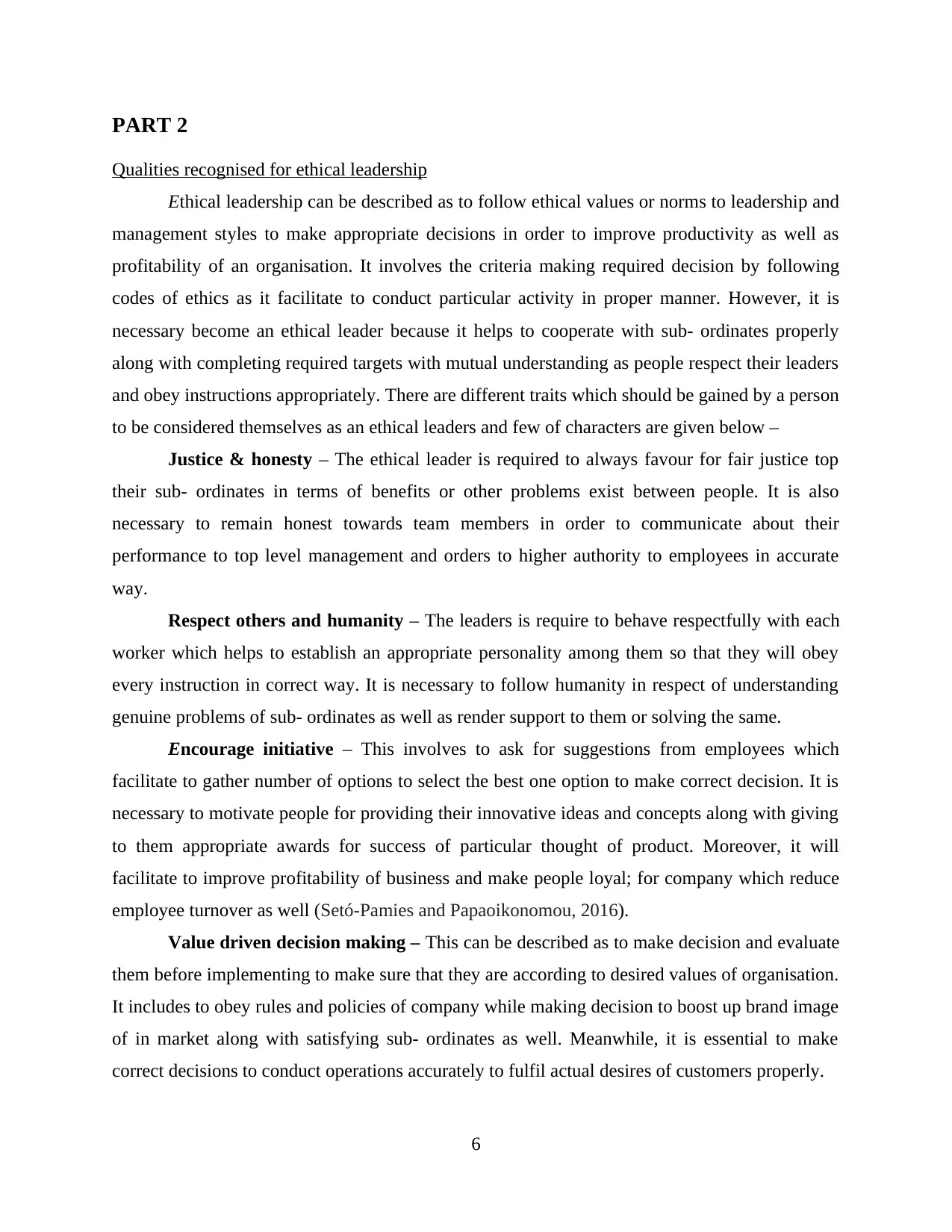
PART 2
Qualities recognised for ethical leadership
Ethical leadership can be described as to follow ethical values or norms to leadership and
management styles to make appropriate decisions in order to improve productivity as well as
profitability of an organisation. It involves the criteria making required decision by following
codes of ethics as it facilitate to conduct particular activity in proper manner. However, it is
necessary become an ethical leader because it helps to cooperate with sub- ordinates properly
along with completing required targets with mutual understanding as people respect their leaders
and obey instructions appropriately. There are different traits which should be gained by a person
to be considered themselves as an ethical leaders and few of characters are given below –
Justice & honesty – The ethical leader is required to always favour for fair justice top
their sub- ordinates in terms of benefits or other problems exist between people. It is also
necessary to remain honest towards team members in order to communicate about their
performance to top level management and orders to higher authority to employees in accurate
way.
Respect others and humanity – The leaders is require to behave respectfully with each
worker which helps to establish an appropriate personality among them so that they will obey
every instruction in correct way. It is necessary to follow humanity in respect of understanding
genuine problems of sub- ordinates as well as render support to them or solving the same.
Encourage initiative – This involves to ask for suggestions from employees which
facilitate to gather number of options to select the best one option to make correct decision. It is
necessary to motivate people for providing their innovative ideas and concepts along with giving
to them appropriate awards for success of particular thought of product. Moreover, it will
facilitate to improve profitability of business and make people loyal; for company which reduce
employee turnover as well (Setó-Pamies and Papaoikonomou, 2016).
Value driven decision making – This can be described as to make decision and evaluate
them before implementing to make sure that they are according to desired values of organisation.
It includes to obey rules and policies of company while making decision to boost up brand image
of in market along with satisfying sub- ordinates as well. Meanwhile, it is essential to make
correct decisions to conduct operations accurately to fulfil actual desires of customers properly.
6
Qualities recognised for ethical leadership
Ethical leadership can be described as to follow ethical values or norms to leadership and
management styles to make appropriate decisions in order to improve productivity as well as
profitability of an organisation. It involves the criteria making required decision by following
codes of ethics as it facilitate to conduct particular activity in proper manner. However, it is
necessary become an ethical leader because it helps to cooperate with sub- ordinates properly
along with completing required targets with mutual understanding as people respect their leaders
and obey instructions appropriately. There are different traits which should be gained by a person
to be considered themselves as an ethical leaders and few of characters are given below –
Justice & honesty – The ethical leader is required to always favour for fair justice top
their sub- ordinates in terms of benefits or other problems exist between people. It is also
necessary to remain honest towards team members in order to communicate about their
performance to top level management and orders to higher authority to employees in accurate
way.
Respect others and humanity – The leaders is require to behave respectfully with each
worker which helps to establish an appropriate personality among them so that they will obey
every instruction in correct way. It is necessary to follow humanity in respect of understanding
genuine problems of sub- ordinates as well as render support to them or solving the same.
Encourage initiative – This involves to ask for suggestions from employees which
facilitate to gather number of options to select the best one option to make correct decision. It is
necessary to motivate people for providing their innovative ideas and concepts along with giving
to them appropriate awards for success of particular thought of product. Moreover, it will
facilitate to improve profitability of business and make people loyal; for company which reduce
employee turnover as well (Setó-Pamies and Papaoikonomou, 2016).
Value driven decision making – This can be described as to make decision and evaluate
them before implementing to make sure that they are according to desired values of organisation.
It includes to obey rules and policies of company while making decision to boost up brand image
of in market along with satisfying sub- ordinates as well. Meanwhile, it is essential to make
correct decisions to conduct operations accurately to fulfil actual desires of customers properly.
6
⊘ This is a preview!⊘
Do you want full access?
Subscribe today to unlock all pages.

Trusted by 1+ million students worldwide

Creation of an ethical organisation
Ethical organisation refers to to establish and run business by following overall
organisational ethics in appropriate manner. It involves principals and standards through which
businesses can operate as per required idea in order to fulfil needs of customers by gaining better
outcomes. However, it is necessary for them to conduct their production activities through
applying acts of fairness, compassion, integrity, honour and responsibility. In addition to this,
ethical values are helpful to analyse actual desires of people and facilitate to put efforts in correct
direction for achieving set goals and objectives successfully. Moreover, there are several
methods which can be used to organise an ethical business concerns in which some of ways are
given below.
Initially, it is necessary to establish ethical stance and understand staff members in proper
manner so that they can perform in accurate way in terms of improving their productivity with
perfection. However, it involves to recruit people for ethics, demonstrate ethical standards while
conducting operations and other relevant procedure of business. Moreover, it is necessary to
provide training to make ethical decision making and give benefits or rewards for appropriate
ethical behaviour of employees. Additionally, overall ethical norms and values should be
followed to establish a correct ethical organisation properly.
CONCLUSION
From the above report, it is conclude that business ethics includes several ethical rules or
norms which should be followed to establish business properly along with earning better profits.
It involves ethical dimensions such as social issue, stakeholders, government and product image.
In addition to this, impacts of ethical choices of different stakeholders including employees,
government authorities, investors and customers. Moreover, it includes qualities for ethical
leadership like justice & honesty, respect others & humanity, encourage initiative and value
driven decision making.
7
Ethical organisation refers to to establish and run business by following overall
organisational ethics in appropriate manner. It involves principals and standards through which
businesses can operate as per required idea in order to fulfil needs of customers by gaining better
outcomes. However, it is necessary for them to conduct their production activities through
applying acts of fairness, compassion, integrity, honour and responsibility. In addition to this,
ethical values are helpful to analyse actual desires of people and facilitate to put efforts in correct
direction for achieving set goals and objectives successfully. Moreover, there are several
methods which can be used to organise an ethical business concerns in which some of ways are
given below.
Initially, it is necessary to establish ethical stance and understand staff members in proper
manner so that they can perform in accurate way in terms of improving their productivity with
perfection. However, it involves to recruit people for ethics, demonstrate ethical standards while
conducting operations and other relevant procedure of business. Moreover, it is necessary to
provide training to make ethical decision making and give benefits or rewards for appropriate
ethical behaviour of employees. Additionally, overall ethical norms and values should be
followed to establish a correct ethical organisation properly.
CONCLUSION
From the above report, it is conclude that business ethics includes several ethical rules or
norms which should be followed to establish business properly along with earning better profits.
It involves ethical dimensions such as social issue, stakeholders, government and product image.
In addition to this, impacts of ethical choices of different stakeholders including employees,
government authorities, investors and customers. Moreover, it includes qualities for ethical
leadership like justice & honesty, respect others & humanity, encourage initiative and value
driven decision making.
7
Paraphrase This Document
Need a fresh take? Get an instant paraphrase of this document with our AI Paraphraser
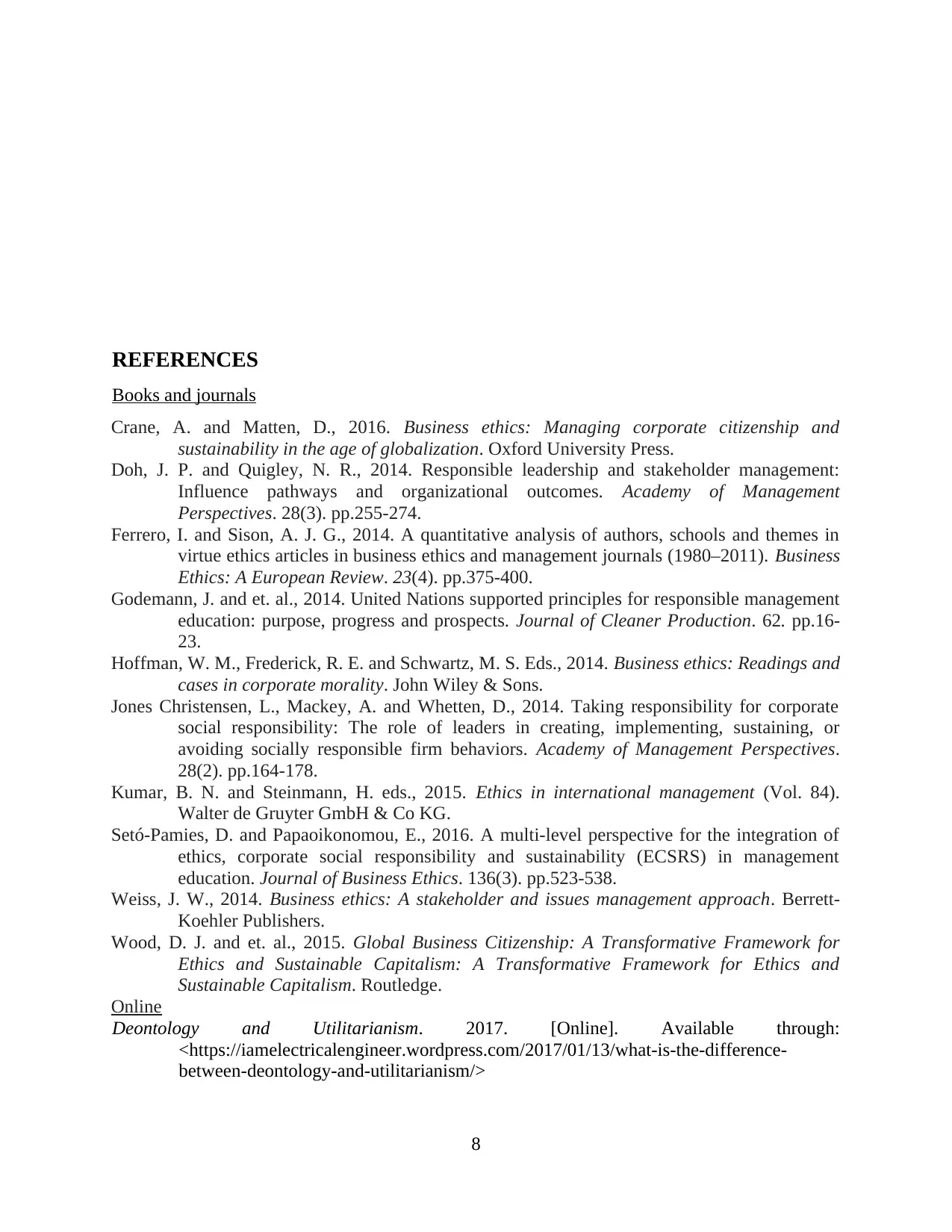
REFERENCES
Books and journals
Crane, A. and Matten, D., 2016. Business ethics: Managing corporate citizenship and
sustainability in the age of globalization. Oxford University Press.
Doh, J. P. and Quigley, N. R., 2014. Responsible leadership and stakeholder management:
Influence pathways and organizational outcomes. Academy of Management
Perspectives. 28(3). pp.255-274.
Ferrero, I. and Sison, A. J. G., 2014. A quantitative analysis of authors, schools and themes in
virtue ethics articles in business ethics and management journals (1980–2011). Business
Ethics: A European Review. 23(4). pp.375-400.
Godemann, J. and et. al., 2014. United Nations supported principles for responsible management
education: purpose, progress and prospects. Journal of Cleaner Production. 62. pp.16-
23.
Hoffman, W. M., Frederick, R. E. and Schwartz, M. S. Eds., 2014. Business ethics: Readings and
cases in corporate morality. John Wiley & Sons.
Jones Christensen, L., Mackey, A. and Whetten, D., 2014. Taking responsibility for corporate
social responsibility: The role of leaders in creating, implementing, sustaining, or
avoiding socially responsible firm behaviors. Academy of Management Perspectives.
28(2). pp.164-178.
Kumar, B. N. and Steinmann, H. eds., 2015. Ethics in international management (Vol. 84).
Walter de Gruyter GmbH & Co KG.
Setó-Pamies, D. and Papaoikonomou, E., 2016. A multi-level perspective for the integration of
ethics, corporate social responsibility and sustainability (ECSRS) in management
education. Journal of Business Ethics. 136(3). pp.523-538.
Weiss, J. W., 2014. Business ethics: A stakeholder and issues management approach. Berrett-
Koehler Publishers.
Wood, D. J. and et. al., 2015. Global Business Citizenship: A Transformative Framework for
Ethics and Sustainable Capitalism: A Transformative Framework for Ethics and
Sustainable Capitalism. Routledge.
Online
Deontology and Utilitarianism. 2017. [Online]. Available through:
<https://iamelectricalengineer.wordpress.com/2017/01/13/what-is-the-difference-
between-deontology-and-utilitarianism/>
8
Books and journals
Crane, A. and Matten, D., 2016. Business ethics: Managing corporate citizenship and
sustainability in the age of globalization. Oxford University Press.
Doh, J. P. and Quigley, N. R., 2014. Responsible leadership and stakeholder management:
Influence pathways and organizational outcomes. Academy of Management
Perspectives. 28(3). pp.255-274.
Ferrero, I. and Sison, A. J. G., 2014. A quantitative analysis of authors, schools and themes in
virtue ethics articles in business ethics and management journals (1980–2011). Business
Ethics: A European Review. 23(4). pp.375-400.
Godemann, J. and et. al., 2014. United Nations supported principles for responsible management
education: purpose, progress and prospects. Journal of Cleaner Production. 62. pp.16-
23.
Hoffman, W. M., Frederick, R. E. and Schwartz, M. S. Eds., 2014. Business ethics: Readings and
cases in corporate morality. John Wiley & Sons.
Jones Christensen, L., Mackey, A. and Whetten, D., 2014. Taking responsibility for corporate
social responsibility: The role of leaders in creating, implementing, sustaining, or
avoiding socially responsible firm behaviors. Academy of Management Perspectives.
28(2). pp.164-178.
Kumar, B. N. and Steinmann, H. eds., 2015. Ethics in international management (Vol. 84).
Walter de Gruyter GmbH & Co KG.
Setó-Pamies, D. and Papaoikonomou, E., 2016. A multi-level perspective for the integration of
ethics, corporate social responsibility and sustainability (ECSRS) in management
education. Journal of Business Ethics. 136(3). pp.523-538.
Weiss, J. W., 2014. Business ethics: A stakeholder and issues management approach. Berrett-
Koehler Publishers.
Wood, D. J. and et. al., 2015. Global Business Citizenship: A Transformative Framework for
Ethics and Sustainable Capitalism: A Transformative Framework for Ethics and
Sustainable Capitalism. Routledge.
Online
Deontology and Utilitarianism. 2017. [Online]. Available through:
<https://iamelectricalengineer.wordpress.com/2017/01/13/what-is-the-difference-
between-deontology-and-utilitarianism/>
8
1 out of 11
Related Documents
Your All-in-One AI-Powered Toolkit for Academic Success.
+13062052269
info@desklib.com
Available 24*7 on WhatsApp / Email
![[object Object]](/_next/static/media/star-bottom.7253800d.svg)
Unlock your academic potential
Copyright © 2020–2025 A2Z Services. All Rights Reserved. Developed and managed by ZUCOL.





